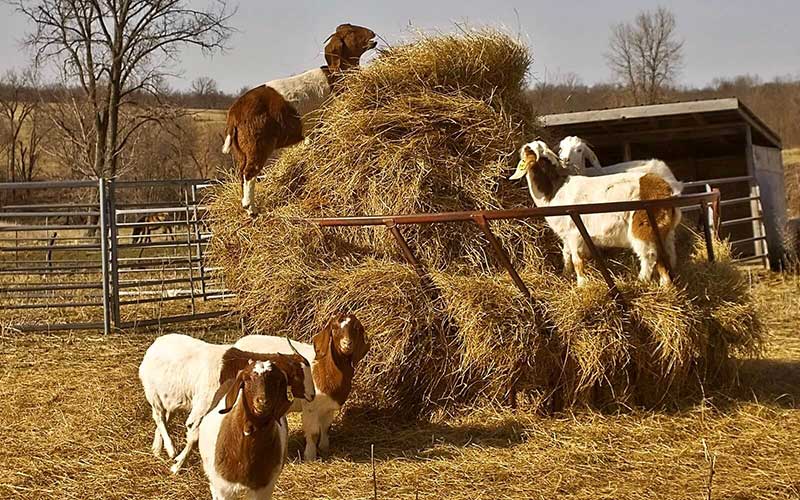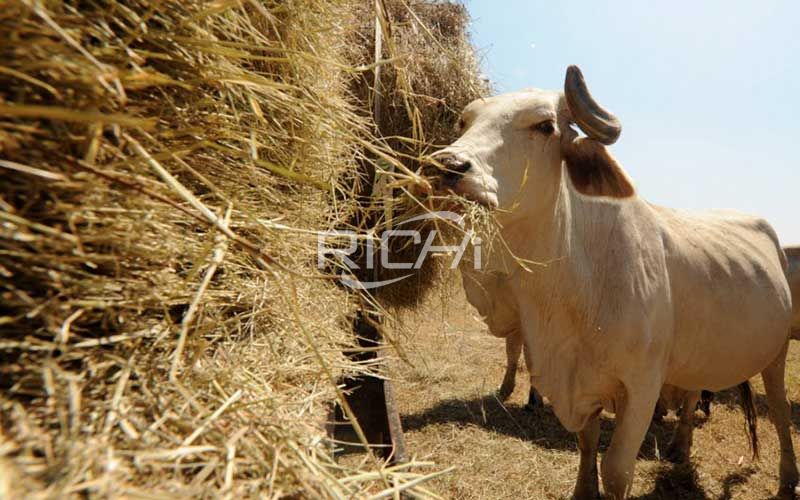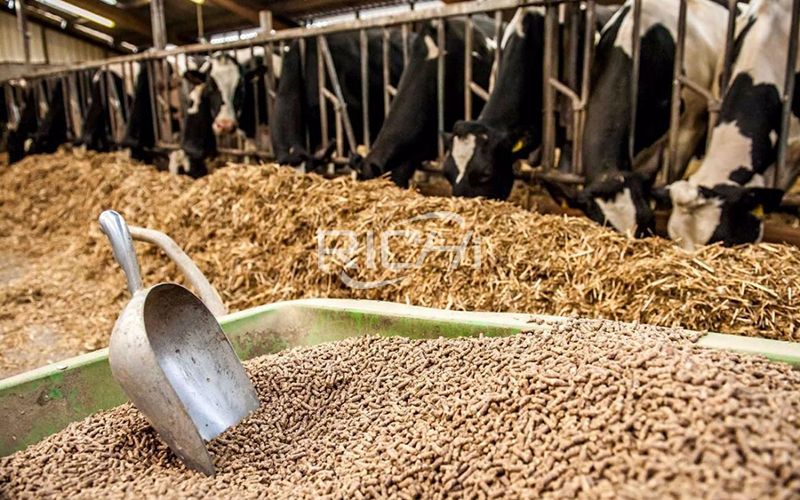
This is where you find all our press releases and news articles.
Straw biological pellet feed is a scientifically formulated "group bacteria enzyme" preparation that utilizes nearly a hundred microorganisms, especially photosynthetic bacteria, actinomycetes, yeasts, lactic acid bacteria, and Aspergillus, to ferment plants and produce cost A nutritious feed with low nutrition and high nutrition.

Sheep eat straw
After the straw biological pellet feed enters the animal gastrointestinal tract, it can form a strong dominant population with the beneficial bacteria in the gastrointestinal tract, inhibit and eliminate pathogenic bacteria, and secrete and synthesize a large number of amino acids, proteins, vitamins, various biochemical enzymes, and antibiotics. Promote growth factors and other nutrients and hormones. These substances and functions are the main effects of straw biological pellet feed.
After the straw is fermented with bacterial enzymes, the cellulose, starch, protein and other complex macromolecular organic substances in the straw are degraded into small molecular substances such as monosaccharides, disaccharides and amino acids that are easily digested and absorbed by animals, which increases the amount of volatile fatty acids in the stomach. So that the starch and cellulose in the straw feed are saccharified, nitrogen and other components constitute bacterial protein and growth enzymes, which promote animal growth and disease resistance. At the same time, the crude feed produces and accumulates nutrient-rich microbial cells during the enzymatic process.
Metabolites, such as amino acids, organic acids, alcohols, aldehydes, esters, vitamins, hormones, trace elements, etc., make the feed taste fragrant, improve the functions of livestock and poultry bodies and organs, increase feed intake, and improve the immunity of livestock and poultry , Increase nutrition, stimulate growth, reduce feed costs, and improve economic benefits.
Increase nutrition: After the straw is fermented by the group bacteria enzyme, the cellulose, starch, protein and other complex macromolecular organic substances are degraded into small molecular substances such as monosaccharides, disaccharides and amino acids that are easily digested and absorbed by animals, making the stomach volatile The amount of fatty acids increases, so that starch and cellulose in the straw feed are saccharified, nitrogen and other components constitute bacterial protein and growth enzymes, which promote animal growth and disease resistance.
At the same time, the coarse feed produces and accumulates nutrient-rich microorganisms during the enzymatic process. The body and its useful metabolites, such as amino acids, organic acids, alcohols, aldehydes, esters, vitamins, hormones, trace elements, etc., make the feed taste fragrant, improve the functions of livestock and poultry bodies and organs, increase feed intake and increase livestock Poultry's immunity increases nutrition.
Changes in starch starch generally begins to expand at 50-60 degrees and loses the previous crystal structure. As the temperature increases, the starch granules continue to expand until they burst, causing the starch to undergo a gelation reaction (ie, the denaturation or gelatinization of starch) . Gelatinization promotes the enzymatic hydrolysis of starch in the intestinal tract and is easier to digest. Under the action of microorganisms, lactic acid is produced in the animal's stomach. Lactic acid has the function of inhibiting the growth of pathogens in animal metabolism.

cattle eat straw
Changes in protein can denature the protein, inactivate many anti-nutritional factors, and at the same time change the tertiary structure of the protein and shorten the hydrolysis time of the protein in the intestine. Since gelatinized starch embeds other nutrients in the starch matrix, the protein is also protected by the starch material. Therefore, it is not easy to lose during feeding. Only when the digestive enzymes in ruminants decompose starch, the protein can be released, which can avoid animals. Produce ammonia poisoning and improve protein utilization.
The change of crude fiber can tear the tissue structure and part of the fibrous structure on the surface of the colloidal layer of the material, and change the structure of lignin. The connection between cellulose and lignin is cut off, destroying the barrier effect of lignin among silicon cells. At the same time, the surface area of the material is enlarged, which creates good conditions for the attachment and reproduction of rumen microorganisms. It can also make the material softer and improve its palatability.
The change of crude fat can release the encapsulated fat in the raw material molecules and increase the heat value of the fat. Natural lipase is generally inactivated at 50-70 degrees. High temperature can completely inactivate the lipase and inhibit the degradation of oil.
It can also form compound lipoprotein or lipopolysaccharide together with oil and starch or protein, which reduces the free acid content and is beneficial to animal digestion and absorption.
The change of microorganisms can kill a large number of pathogenic microorganisms (such as Escherichia coli, Salmonella, protozoa and residual pesticides) and improve the hygiene quality of feed.
First, it can increase the nutritional value, and generally increase the crude protein content by 4 to 6%; second, it can increase the palatability and digestibility, and the general feed intake can be increased by 20 to 40%, and the digestibility can be increased by 10 to 20%. The milk production is increased by about 10%; the third is the low cost, simple operation and easy promotion.

Straw pellets
1. Characteristics of straw biological pellet feed
Small size, large capacity, generally loose forage grass, the bulk density of straw is 20-50 kilograms per cubic meter, and the bulk density of compressed into blocks is 800-1000 kilograms per cubic meter, which is convenient for storage and transportation, and is not easy to burn. Under ventilated, moisture-proof and waterproof conditions, the shelf life is 2-3 years or longer.
Good palatability The straw biological pellet feed has a unique and rich paste flavor, good palatability, high degree of maturation, and has a good food attractant effect. It can reduce metabolic diseases and benefit the health of livestock.
Good nutritional content, high digestion and absorption rate The crude protein of general straw biological pellet feed can reach more than 8%, which is equivalent to the nutritional level of medium forage. The feed intake rate can reach more than 99%, and the digestion and absorption rate can reach more than 60%.
Feeding loss is less, loose grass feeding loss is about 30%, bale feeding loss is about 15%, straw biological pellet feed is less than 1%, which improves feed utilization and saves feeding costs.
Convenient feeding The straw biological pellet feed can be fed wet or dry, saving labor, labor, time, and mechanized feeding.
Reduce the comprehensive utilization of polluted straws, return to the fields through the belly, realize a virtuous cycle of agriculture, reduce the use and pollution of chemical fertilizers, and improve the benefits of the planting industry.
2. Product quality standards and equipment requirements
(1) Dry storage of straw bale (briquetting)
Straw bundling (bridging) dry storage is to process the harvested corn stalks, bean straws and other crop stalks with a forage straw kneading machine to destroy the rough outer skin and hard knots of the straw at one time, and knead them into no hard knots. , The softer filamentous loose crushed forage material, after natural drying to reach safe storage moisture, then press it into a (30×30×60~80) cm straw bale with a baler, or use forage hydraulic pressure The machine is packed and compressed into large cross-section straw blocks (60×40×20cm). The packaging method of straw bales (blocks) is simple and the cost is very low. You can use a baler to hit two 12mm wide PVC belts along the length and width directions, or use a simple nylon mesh bag set.
After the straw is bundled (briquetting), the product density can reach 3,000~400kg/m3, which can be stacked and stored regularly, and the storage and transportation volume is reduced by 5~7 times compared with the naturally stacked forage. In the process, space can be saved, transportation costs can be greatly reduced, and long-distance transportation as a commodity is more economical. This processing technology is relatively simple and has the lowest cost. Other straw forage products are basically further processed on the basis of straw bales (blocks). Therefore, straw baling (briquetting) dry storage technology is a large-scale development of straw Utilization and development of commodity production provide solutions, which will surely be the most widely used.
(2) Straw bag micro-storage
Straw bag micro-storage is the use of a straw squeezing and kneading machine to flatten, cut and knead the corn stalks into filamentous forage at one time, spray starter and beneficial microorganisms in the grass filaments, add salt water, stir, and then compress. Bundled, sealed, packaged, and subjected to anaerobic fermentation, not only maintains the freshness of the straw, but also improves the quality of the straw forage, forming a new type of high-quality forage. The bagged micro-storage straw has been treated with microorganisms to have better quality and soft aroma. It not only preserves the vitamins and proteins in the silage straw to the maximum extent, but also produces a large amount of food that is beneficial to the digestion of cattle and sheep and inhibits bacteria Growing organic acids and bacterial protein, etc., improve the nutritional value of the forage, with good palatability, high feed intake and digestion and utilization; due to the use of independent sealed packaging, mold and external pollution are eliminated, and it can be stored for a long time. It does not deteriorate and can be stored for up to two years; it is convenient to store, and can keep the freshness of the grass, and also saves the cost of building pits; the production of bagged micro-storage forage is simple, not affected by weather and site restrictions, saving people , Labor-saving, time-saving, easy to organize production, easy to transport, easy to market operation. The finished bales are small in size, high in density, easy to transport, suitable for long-distance transportation, and can meet the needs of merchants from all over the world. As bagged silage becomes a real green forage, it can provide green and succulent feed for cattle and sheep all year round, solving the problem of "grass shortage" in winter and spring.
(3) Production of straw briquette feed
The production of straw briquetted feed refers to the crushing of crop straws, adding concentrates or additives according to the requirements of the formula, and mixing them thoroughly, and then compressing them into block feeds of 32mm×32mm×30~80mm to improve the nutritional value of the straws and feed intake The volume and digestibility are convenient for storage, transportation and mechanized feeding, and it is convenient to enter the commodity circulation.
The more advanced technological process of large-scale briquetting production with a briquetting machine is to first air-dry or dry the crop straws to a moisture content of about 15%, then use a crusher to knead and cut the straws into sections of 3 to 5 cm, which are fed by a conveyor Metering box or continuous mixer, then add bentonite and water (the purpose is to improve the agglomeration), then the crushed hay, bentonite and water are fully mixed in the mixer and discharged into the briquetting machine. The cooler is cooled, the moisture content can be reduced to below 14% after cooling, and it can be safely stored, and then sent to the finished product warehouse by the conveyor belt for quantitative packaging. The process flow is shown in Figure 3. It is also possible to add concentrated feed and additives according to the requirements of the formula and mix thoroughly with the broken straws before briquetting. Adopting the above-mentioned technology requires large investment in equipment and workshops and high productivity, which is suitable for industrialized production.
The briquetting machine is the core machine of the production technology. The mixed straw material is continuously pushed into the compression chamber, and then pushed to the die hole by the eccentric pressure roller. During the advancement of the raw materials, due to the combined effect of the thrust of the pressure roller, the resistance of the die, the friction and deformation between the straws, a series of physical and chemical reactions occur in the straw raw materials, the density increases, the temperature rises, and the organic composition changes. From raw food to mature food. Through the action of high temperature and high pressure, not only the volume is small, the density is high, harmful molds are killed, and it is convenient for long-term storage and transportation, but the starch and sugar substances in the raw materials also undergo an enzymatic reaction, giving the feed a strong paste smell. Increase the palatability of livestock and increase feed intake.
Straw blocks are commonly known as "compressed biscuits" for cattle and sheep. The density is greatly increased, generally 0.7-1t/m3, and the bulk density is 0.4-0.6t/m3, which greatly reduces storage and transportation costs, especially for long-distance transportation or export. Compared with straw bales, because straw blocks do not need to be bundled, the expenses for loading, unloading, storage, and distribution of feed are reduced. Also, due to the higher density and bulk density of the straw bales, the storage space is 1/3 less than that of the straw bales. Feeding loss is 10% lower than that of straw bales, so it is more advantageous than straw bales in transportation, storage, and feeding. Compared with straw pellets, the straw does not need to be crushed very finely before briquetting, thus saving Crushing energy consumption and keeping hay at a certain fiber length is more suitable for the physiological needs of ruminant livestock. It is more convenient and hygienic to feed the livestock with dry straw blocks, and it can also be easily mixed with silage or concentrate to provide full-price rations for livestock.
(4) Processing of straw pellet feed
Straw pellet machine is the use of granulating equipment to press the straw into granular feed after kneading and crushing the straw into powder. The whole process includes coarse crushing, fine crushing, mixing, granulating, packaging and auxiliary systems. The process flow is as attached As shown in the figure. Because straw powder has high fiber content, needle-like shape, crosses each other, poor fluidity, large friction coefficient, poor granulation performance, and its productivity is much lower than that of general powdered feed, only about 1/5; when granulating grass The resistance between the powder and the pressing hole is large, and the wear of the pressing mold is serious.
In the process of processing straw pellets, concentrates and other nutrients are often added to form a complete feed, which not only improves the pelleting performance, but also complements the nutrition and gives full play to the nutritional value of the feed. In order to improve the granulation performance, the moisture content of the straw powder should also be controlled. If the moisture content is too high, the particles are soft and easy to block the mold holes, and the moisture content is too low, and it is difficult to form. Usually, spray hot water or steam during the granulation to moisten the grass. The amount of powder introduced is generally controlled at 3% to 6% of the amount of feed, so that the grass powder can reach a suitable moisture content of 14% to 16%. This moisture content can increase the plasticity of the raw material, and the pressed water has a lubricating effect. , Can improve granulation. The grass powder should also be pulverized finer, or about 5% of oil or molasses can be added to the grass powder raw materials to improve the bonding effect, so that the grass particles are formed well. Although the oil is not sticky, it has a lubricating effect. Reduce the wear of the pellet machine die and reduce energy consumption.
Straw pellet feed has the advantages of good palatability, large feed intake of livestock, short feed time and less waste, but its equipment cost and operating cost are high. The technical requirements for the straw pellet production line are that the product shape and size should be relatively uniform, have a hardness that will not break, and the surface should be smooth and clean. The diameter of the particles is generally between 10 and 30 mm, which can be determined according to the feeding object. The smaller the livestock and poultry, the smaller the required particles. The particle density is preferably 1.2~1.3g/cm3, and the bulk density of the particles is between 550~600kg/m3.
Having the right mix of reliable, high-quality pellet machine and pelletizing systems and expert support is essential to your success. Watch how our end-to-end feed pellet plant solutions have helped our customers optimize their performance.
Our customized and future-proofed turnkey pellet plant solutions is designed with you at the core. From vision to reality and beyond, our team stays connected with yours. Giving you peace-of-mind with an expert at your side.

At RICHI, we go beyond project completion. With RICHI Servicee, we’re your dedicated partners in success. Count on us for expert guidance, minimal downtime, and optimized productivity. Choose RICHI for unmatched service and support.



Meet global product demands and quality standards with industry-leading pellet plant design, engineering, equipment, and construction services for pellet processors.


Your Partner Beyond Project Completion
2000+ cases
RICHI is the leading designer, manufacturer and builder of pellet plants in the world, completing over 2000 projects in 140 countries across 6 continents.
Read More
Increase plant productivity, profitability, and safety by integrating high quality equipment into your pellet production line. Over the years, RICHI has become China's top pellet equipment manufacturer. At the same time, RICHI has established valuable partnerships with the world's leading component and raw material manufacturers to bring you the best there is in technology, automation, and efficiency in pelleting plant machinery.

For nearly 30 years, RICHI has been providing best-in-class pellet plant equipment and services to clients across a variety of industries, sizes, and needs. We pride ourselves on the knowledge and skill that each team member possesses – from our technical sales team to our process design engineers. You can count on RICHI Machinery to take your operation to the next level of innovation, quality, and success.
Need help with your pellet manufacturing plant project? Contact us today.
ANIMAL FEED
BIOMASS
WOOD
ORGANIC FERTILIZER
AQUA FEED
CAT LITTER
MUNICIPAL WASTE RECYCLING
SPECIAL PELLET PRODUCTION
RICHI Machinery continues to deliver world class pellet mill equipment, pellet plant engineering and project solutions that add value to our customers in the animal feed, wood waste, agriculture waste, organic fertilizer, cat litter and special pellet products industries. Throughout the years, we RICHI Machinery have built strong brand, becoming industry-leading pellet machine manufacturer. We value integrity, promise quality, and prioritize your success.
Learn MoreWith our expert team, we precisely implement your process engineering requirements in pellet mill and pelletizing plant systems. No matter which industry you’re in – we understand your needs and deliver solutions that meet the highest standards.
At RICHI, quality comes first. Our pellet making machine and related pellet line equipment undergo rigorous quality controls to ensure they meet the highest standards. Rely on products that are durable, safe, and efficient.
With decades of experience in pellet machine and pellet production line production, we have earned a reputation as a trusted partner in various industries. Our expertise allows us to cover a wide range of applications.
Not only do we offer premium pelleting equipment, but we are also experts at designing, building, installing, and maintaining facilities from the ground up. Our expertise is within pellt plant process design, discovering the most efficient, productive, and profitable way to handle your materials in an end-to-end cycle.

Keeping in touch with us is an effective way to solve all your problems. If you have any needs or questions, please leave your contact information, then RICHI technical consultants will send design, quotation, videos to your mailbox. You can also contact us directly via WhatsApp: +86 13838389622
Copyright©2015-2024 by HENAN RICHI MACHINERY CO., LTD. All rights reserved.